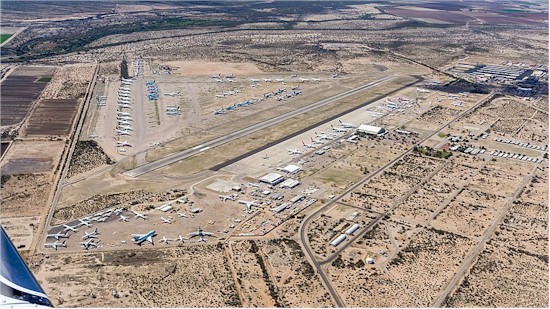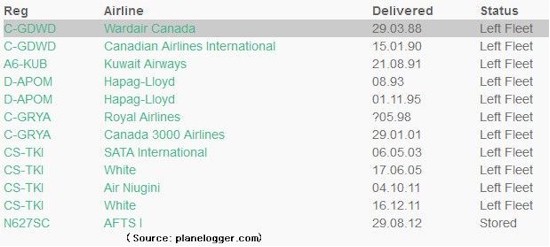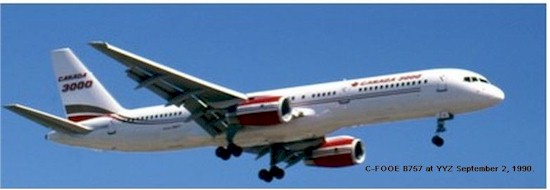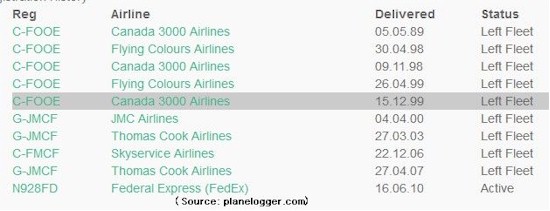|
Subscriber Stephen Helms brought to our attention that Air Canada's first Boeing 777-333ER, Fin #731 (C-FITL), has been returned to the lessor. Originally delivered in March 2007, the aircraft is only 14 years old. It was withdrawn from service in March 2020 and stored at MZJ (Pinal Airpark) until this past August when it was flown to SIN (Singapore), possibly for a heavy maintenance check, and then returned to MZJ via YVR on October 19, 2021. Sources: |
 |
| Photo by Brian @ commons.wikimedia.org |
 for the latest posts at the Air Canada Mediaroom. for the latest posts at the Air Canada Mediaroom. |
 Click the logo to open the Air Canada YouTube channel. Click the logo to open the Air Canada YouTube channel. |
|
Larry Milberry has this memory on his blog on the web site www.canavbooks.wordpress.com. We have permission from Larry, to reprint this memory – |
|
Here are a few of the aircraft that were spotted at YYZ on these two Canadian International Air Show media days airside at YYZ, September 1 and 3, 1990.
Delivered to Wardair in March 1988, it was named in honour of the great Austin Airways bush pilot, Thurston "Rusty' Blakey. When Wardair was acquired by Canadian Airlines International, "DWD" moved there, then had various other owners and operators, Montreal's Royal Airlines and Toronto's Canada 3000 included (where it flew as C-GRYA). Finally, it became N627SC just before being broken up for scrap in 2014 at Pinal Airpark in Arizona. For extra fun, below is a satellite view of Pinal Airpark, where the main business is scrapping old airliners. |
 |
|
Lifecycle of C-GDWD |
 |
|
Boeing 757 C-FOOE began with Canada 3000 in May 1989, then was G-JMCF with UK operator JMC Airlines. Other operators followed until it was sold to FedEx in 2010 to become freighter N928FD. There it has served solidly as a freighter. On July 16, 2021, for example, it operated Indianapolis-New Orleans-Atlanta, logging 2:36 hours. |
 |
| Lifecycle of C-FOOE |
 |
| Subscriber George Trussell shares his personal memory of flying rhesus monkeys on Maritime Central Airways from India as first mentioned in NetLetter # 1471. |
|
I was not an old captain but I was an 'Animal Attendant' on two MCA flights from LHR to Canada in 1957 and I can confirm that the monkey smell was very strong and lingering. I was employed by MCA as the office boy in early 1957, just short of my 18th birthday, after working for BOAC for the past year. My boss was Dick Burge who had been an 'Animal Attendant' with BOAC and was now employed as the Station Mgr at LHR as well as working the 'Monkey Flights'. During the summer we had passenger flights including British emigrants to Canada and Group Charters. The DoT Inspectors kept checking out those flights - when issued their tickets, passengers also received a membership card to some society such as the Scarborough Fur and Fin Club and were instructed to tell the Inspectors if asked that they had attended at least two meetings per year. MCA also operated flights from VIE (Vienna) with Hungarian refugees. Al Koerner was the Engineer there and he positioned to LHR to assist us; later he became a flight engineer with Nordair I believe. The first flight I took was in October 1957 loaded with 1600 monkeys in three rows down the cabin leaving a narrow space against the port side for access to the doors and toilets. We had a row of seats between the bulkhead and monkeys on one side. The monkeys were in flimsy wood and chicken wire boxes containing between six and nine per box. Before loading, a roll of thick clear vinyl was taped up the sides and across the floor to contain any water and other spills. Our job was to feed and water the monkeys every four hours and empty their trays every eight hours. The monkeys, arriving from either India or Singapore, had a 24 hour stop at the RSPCA Hospital at LHR before the flight. There were strict rules on the carriage regarding the controlled temperature and feeding and although some loss would be expected due previously acquired diseases, an above expected percentage rate would be investigated with potential loss of the business. Deceased monkeys were to be stored for hand over at the receiving end. Our first stop was Keflavik, Iceland for refueling and water top-up for the monkeys, then on to Gander for the same. Also clearance by the Canadian Health / Agriculture Department of us and the monkeys! Then on to YUL where half the load was off-loaded before continuing to Toronto to drop off the remainder. We would then position back to YUL - about a 24+ hour day. The cabin temperature was kept high and if you have ever been in the monkey house at the zoo, you can imagine the smell in the cabin. The flight deck crews never came near us and, when having to leave the flight deck to relieve themselves, held their noses and dashed through the cabin. While the aircraft was being offloaded at YYZ, my boss and I went to the AC hangar to use the biggest washing facility I had ever seen. A big concrete ring that had about twenty taps to allow multi-people washing their hands. We took it a bit further and stripped off our stinking clothes and jumped into the ring to wash off our bodies and hair much to the amusement of those mechanics passing through. I had been advised to wear my oldest clothes to throw out as it was impossible to wash the smell out of them. We were supposed to travel back to LHR within 3 or 4 days on BOAC however we now discovered we would be there 10 days and take the next MCA positioning flight back to LHR and on to India for the next rotation. We would pick it up at LHR on its way back from India with the next load. This was delayed account an Afghanistan Airlines Convairliner damaging the tail area during a refuelling stop at Kabul. The next flight in early November was similar to the above except we had a panic on the final leg. While dozing between YUL and YYZ, something caught my eye over my shoulder. Sitting on top of the crates watching us, rather than inside, were several monkeys! Nudging my boss, we put on our thick leather gloves to retrieve these strays - their crate had probably been damaged during the off-load at YUL. The captain was informed and after contacting YYZ Control, he was advised that he could not land until the monkeys had been secured! Fortunately we caught the escapees quite quickly and did not have to ditch in Lake Ontario. After a return to YUL, I caught a BOAC DC-7C back to LHR. And I still smelt of monkeys! |

